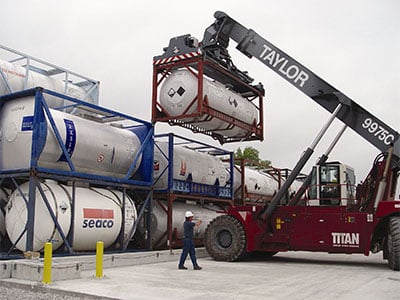Are you aware of your complete cradle to grave responsibilities as a hazardous waste generator?
Understanding the full scope of your obligations under the Resource Conservation and Recovery Act (RCRA) is crucial for avoiding fines and penalties. Yet some hazardous waste generators remain unaware of the extent of their responsibilities. Whether that ignorance is blissful or intentional, the consequences can be severe.
The RCRA is the most comprehensive piece of environmental law that we have on the books today. When the act was created and passed by the US Congress in 1976, it was meant to create a system for controlling hazardous waste from the time it is generated to its final disposal, from “cradle to grave.”
While most hazardous waste generators are aware that they have responsibilities under this law, many fail to realize their “complete” cradle to grave requirements for compliance include storage, transportation and its final disposal. This lack of understanding is evidenced by the significant number of fines and penalties levied by government agencies each year upon corporations and organizations within the United States.
The bottom line, if you generate hazardous waste you can and will be held responsible for its improper off-site transportation and disposal.
Short of transporting, storing, treating, and disposing of your hazardous waste yourself, how can you minimize your company’s potential liability once the hazardous waste is out of your hands?
Let’s take a look at some frequently asked questions you may have about cradle to grave requirements and what you need to know about choosing your hazardous waste disposal vendor.
What Does Cradle to Grave Mean?
“Cradle to grave” states that a hazardous waste generator is responsible for its waste from initial generation through its ultimate disposal and beyond. Nothing will relinquish a generator of this responsibility. There’s no expiration date or time limit, and hiring someone else to transport and dispose of your waste does not transfer responsibility.
That’s why it is vitally important to maintain compliance and ensure you are operating by the book. If an incident occurs at any point during your waste’s lifecycle, you can and will be held liable. It’s possible you may also be obligated to pay some or all costs associated with a response or a cleanup.
Why Is Cradle to Grave Necessary?
In the mid-twentieth century, solid waste management issues became a matter of great public concern in many areas of the United States because of increasing solid waste generation, shrinking disposal capacity, rising disposal costs, and public opposition to the siting of new disposal facilities.
 Several high profile environmental disasters occurred, during the late sixties through the 1970’s including the Cuyahoga River fire and the Love Canal which led to the enactment of many of the federal environmental statutes on the books today, most notably RCRA.
Several high profile environmental disasters occurred, during the late sixties through the 1970’s including the Cuyahoga River fire and the Love Canal which led to the enactment of many of the federal environmental statutes on the books today, most notably RCRA.
These solid waste management challenges continue today, as many communities are struggling to develop cost-effective, environmentally protective solutions. The growing amount of waste generated has made it increasingly important for solid waste management officials to develop strategies to manage wastes safely and cost effectively.
RCRA sets up a framework for the proper management of hazardous waste. From this authority, EPA established a comprehensive regulatory program to ensure that hazardous waste is managed safely and effectively.
Selecting The Right Hazardous Waste Disposal Company
A properly licensed and experienced hazardous waste disposal company is worth its weight in gold. The right vendor will help you stay in compliance with state and federal regulations, provide minimal disruption to your operations and perform these tasks in a cost-effective manner.
Selecting the right company, however, can be challenging. Here are a few steps to take during your interview process.
Perform Background Checks
Performing due diligence background checks on your vendors is a good business practice that can limit headaches down the road. At a minimum check the following:
- Financial references - Dun &Bradstreet report, Bank letter of credit, etc.
- Insurance – Business liability and workers compensation insurance
- Proper Licensing – EPA, Department of Toxic Substances Control, Department of Transportation
- Regulatory Compliance – Check with the DTSC in California
- Proper training: Employees are properly trained in everyday handling of hazardous materials as well as emergency situations
Ask Questions
During your initial interview with a prospective hazardous waste vendor, it’s a good business practice to ask thorough questions. Here are some questions to start with that address hazardous waste disposal regulations:
questions. Here are some questions to start with that address hazardous waste disposal regulations:
- Where will my waste be sent? This answer could range from hazardous waste landfills to recycling facilities.
- Are the transporter and the Treatment, Storage and Disposal Facility (TSDF) the same company, or are they independent?
- Will the hazardous waste will be delivered to the TSDF that day. If not, when? If there are overnight stops on the road, will the transporter only use secured sites?
- Ask the initial transporter if any other transporters will be used to deliver the hazardous waste to the TSDF. Will the hazardous waste be stored in a 10-day transfer site?
- If the uniform hazardous waste manifest identifies a treatment or storage facility instead of a disposal facility such as a landfill, what is the location of the final destination, i.e. disposal, of the hazardous waste?
- Will the transporter or TSDF assist in the completion of the uniform hazardous waste manifest? As the shipper of a hazardous material, you are ultimately responsible for the correct completion of the manifest.
- What methods does the transporter or TSDF use to avoid spills or leaks and, especially, releases to the environment?
Check References
Ask your prospective vendor to provide the names and phone numbers of current customers as references.
Make sure that you follow up with these references and check to see how satisfied they are with the company's services, employees and the quality of their work. Make sure that you ask the company to provide references that have similar waste streams.
Follow Up On a Regular Basis
Once you have hired a qualified vendor, it's a good business practice to conduct yearly environmental audits of its performance and compliance.
The Registered Hazardous Waste Transporter Database is a great place to start. Any business can run into rough patches and their service can become unreliable. With fines and investigations on the rise, it is more important than ever to work with a reliable company. Make sure that you do your part to ensure that the company is performing.
REMEMBER: Maintaining compliance with your “cradle to grave” requirements cannot be offloaded to your hazardous waste vendor. You have the ultimate responsibility as the generator to ensure federal and state regulations are followed, and YOU maintain the ultimate liability.
It’s understandable that learning the ins and outs of RCRA can be time-consuming and challenging. But if you’re a hazardous waste generator, it’s crucial that you take the time to do so.
Not only will it help you get a better understanding of your legal requirements, it will also help you stay in compliance and avoid significant fines and legal trouble down the road.


Comment